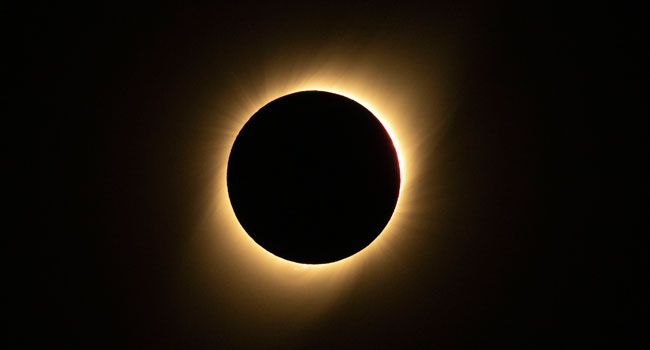It comes with the Sun near the peak of its 11-year solar cycle, setting the stage for a breathtaking display: The corona will glow spectacularly from the Moon’s silhouette along the path of totality, a corridor stretching from Mexico to Canada via the United States.
Total solar eclipses offer “incredible scientific opportunities,” NASA Deputy Administrator Pam Melroy told a press conference this week about the celestial event.
The US space agency is one of the institutions at the ready for the eclipse, with plans to launch so-called “sounding rockets” to study the effects on Earth’s upper atmosphere.
Here is a look at what researchers are hoping to learn from the upcoming eclipse:
– Sun’s atmosphere –
When the Moon passes directly in front of the Sun and blocks it, the elusive outermost edge of the Sun’s atmosphere, or corona, will be visible “in a very special way,” Melroy said.
“Things are happening with the corona that we don’t fully understand,” she said.
The heat within the corona intensifies with distance from the Sun’s surface — a counterintuitive phenomenon that scientists struggle to fully comprehend or explain.
Solar flares, a sudden explosion of energy that releases radiation into space, take place in the corona as do solar prominences, enormous plasma formations that loop out from the Sun’s surface.
During an eclipse, the bottom most part of the corona — where a lot of this activity occurs — is more clearly visible than when using specialized instruments to block the central part of the Sun, offering a golden opportunity for study, said Shannon Schmoll, director of the Abrams Planetarium at Michigan State University.
Researchers are particularly thrilled about the Sun being near the peak of its 11-year cycle.
“The chance we’re going to see something amazing is very high,” Melroy said.
– Earth’s atmosphere –
The total eclipse also will afford scientists a chance to study changes in part of the Earth’s upper atmosphere known as the ionosphere, important because it affects radio waves used for communication and navigation.
California, Irvine.
“What we’re finding is that experiences that bring about awe… seem to attune people and connect us to one another, to connect us to entities that are larger than ourselves,” Piff said.
This year, he plans to study if the experience has any effect on political divisions in society.
– Citizen scientists –
About 40 citizen science projects are planned around the eclipse, from using a phone app to register the temperature and cloud cover to recording ambient noise during the event.
“We encourage you to help NASA observe the sights and sounds around you,” Nelson said.
AFP
